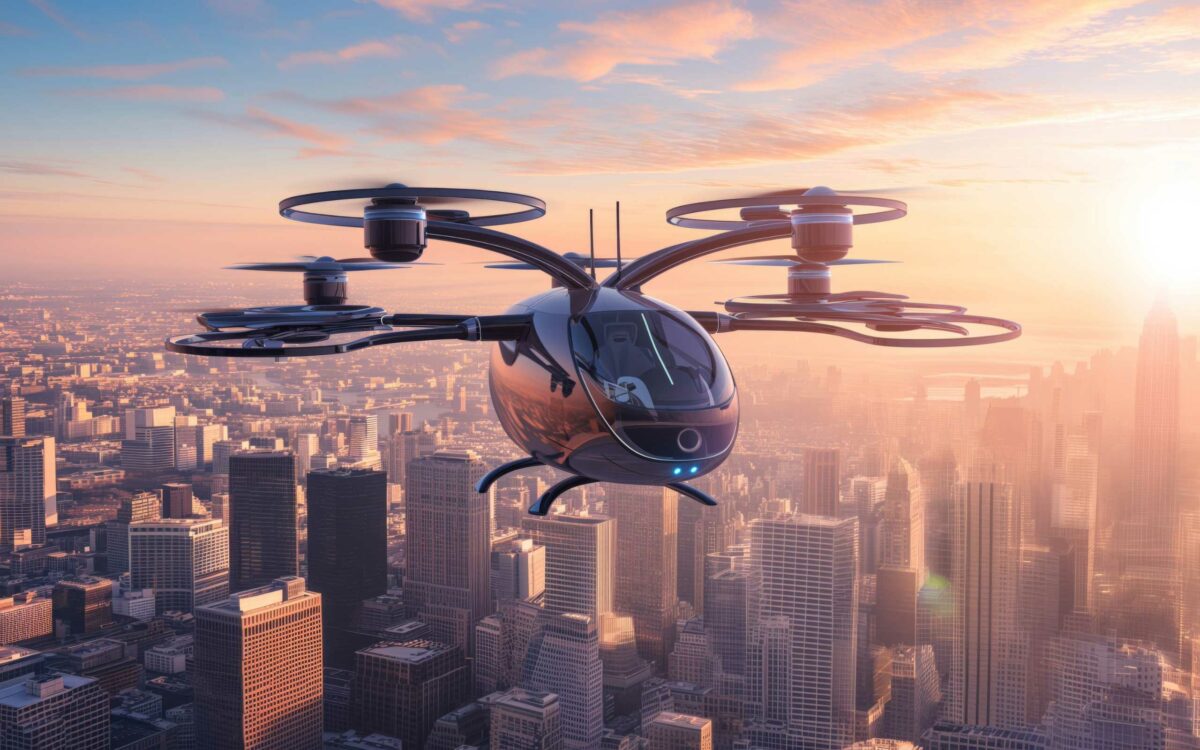Air Taxi in Dubai
- According to a Morgan Stanley Research study, the flying-electric air taxis market is about to unwrap its substantial potential in the next decade, with its value rising to $1.5 trillion globally by 2040.
- This blend of drone technology and convertible car-aircraft may become a more sustainable, green transport solution. Which, in the wake of the straightening global climate crisis becomes a more appealing transport mode.
- Numerous global brands, and some a newcomers trying to mark their names on the map of the rising flying taxi market.
Futuristic flying cars have been a human aspiration since showcased in the famous movie “Back to the Future” in the past century. In the current, 21st century, major brands like Toyota, Uber, Hyundai, Airbus and Boeing are promising a very close transformation of a dream to reality. Most ventures already have a prototype undergoing testing.
Electric air taxis come in quite a few shapes and sizes, and most of experimental models look quite different from conventional fixed-wing aircraft. Electric motors replace jet engines, and vertical takeoff and landing (VTOL) aircraft, designed to avoid the need for long runways, the use of rotating wings & propellers is evolving. Only a few companies are making vehicles that actually look like cars with wings.
Hyundai has presented an electric vertical takeoff and landing (eVTOL) “flying car” concept in early 2020. With two tilt-rotors on the tail, and 10 other rotors distributed around the egg-shaped cabin, the aircraft is designed to take off vertically, transition to wing-borne lift in cruise, and then transition back to vertical flight to land. The five-person vehicle will have a cruising speed of 180 mph (290 km/h) and a cruising altitude of around 1,000–2,000 feet (300–600 meters) above ground.
CityAirbus: Air Taxi in Dubai
A similar concept materialized in the CityAirbus – the new eVTOL being developed by Airbus’ helicopter division for intra-city travel with flying taxis. The futuristic-looking demonstrator can carry four passengers with a range of 60 miles, travelling at 75 miles per hour.
SkyDrive, a Japanese flying taxi startup backed by Toyota, successfully demonstrated a prototype vehicle conducting a crewed flight for the first time in August 2020. The prototype SD-03, is essentially a piloted drone big enough to fit the pilot only. However, SkyDrive plans to develop a two-seat version, which could potentially offer short-distance flights across busy cities, as early as 2023.
In June 2021, German engineered Volocopter completed the first ever public crewed test flight of a fully electrical vertical take-off and landing (eVTOL) air taxi. It can be operated fully autonomously by a pilot using a joystick. Alternatively, it can be remote-controlled from the ground.
Slovakia
July 2021, brought another breakthrough while in Slovakia the first convertible flying car made a successful crewed inter-city test flight. The car-aircraft is equipped with retractable wings, a 160HP BMW engine with a fixed propeller, and a ballistic parachute. The unusual car aircraft can convert from an aircraft to a car in under three minutes. This hybrid car-aircraft created by Klein Vision, is still in the prototype stage but hit a new milestone with its test flight.
No matter the shape and type, an electrical air taxi is meant to resolve important urbanization issues. Urban centres across the globe are struggling with rising vehicle numbers. This leads to increased congestion and pollution, especially during peak traffic hours. When air taxis become widely commercialized, they will definitely ease the traffic burden on city roads. The sustainable nature of air taxi technology allows for a decreased emission impact on the ecology.
It’s not surprising that major auto and aviation companies are rushing to grasp opportunities in this emerging market. The business has the potential to significantly disrupt the landscape of urban mobility. Investors are pouring millions into commercialization efforts. It’s a market that should continue to mature during this decade and then boom globally.
Urban Air Mobility Study (UAM): Air Taxi in Dubai
An urban air mobility (UAM) study, by Frost & Sullivan, suggests the air taxis era will begin in 2022 in Dubai. It will expand with a compound annual growth rate of about 46%. There will be more than 430,000 units in operation by 2040.
But even in spite of all the futuristic prospects and mobility benefits, air taxis are unlikely to fast become a mass market service. The cost of such service is likely to serve as a consumer limitation. It places flying electric taxis and private air-vehicle ownership under the umbrella of more exclusive private aviation.
Morgan Stanley has suggested that the flying car market could begin as “an ultra-niche add-on to existing transportation infrastructure.” It could become similar to how helicopters operate today. Personal helicopter travel is the preference for many privileged people, however, in decades of its existence it hasn’t expanded beyond wealthy passengers.
Pentagon Motor Group ran the numbers. They found that the cost of a flying car will come in at $686,455.43, even more than the 2021 Ferrari SF90 Stradale, which has an MSRP of $625,000. Additionally, flying car buyers will spend an estimated $37,000 for a flying license. They will also pay $17,000 for insurance and nearly $14,000 for parking. According to the group, this amounts to an additional $68,000 in their first year of ownership.
Taking a ride on one of these luxurious vehicles will also not be cheap. It is estimated that a Volocopter air taxi could take passengers for a 15-minute flight at $355. In comparison, Uber’s helicopter ride costs about $200 to $225 for the same trip.
Another potential challenge in moving closer to the era of flying cars is infrastructure. As cars need roads, flying vehicles need some launch/landing platform. VTOLs will not require runways or on-the-ground parking. However, they will need dedicated air corridors and sky harbours. These infrastructures are essential to store craft and will most probably necessitate airports. In the next decade, only wealthy countries will be able to accommodate flying car technology and bring their infrastructure to a functional-for-purpose state. The UK, for example, is building the world’s first airport for flying cars.
The US, China, Dubai, and Israel are all experimenting with flying cars today. Many other places are likely to allow commercial operations by 2025. Dubai is one of the pioneer markets. It is moving first in air taxis. A maiden air taxi test flight with Volocopter was held in September 2017. There is a planned first commercial service launch by 2022.
The estimated cost of a flying car is excessive for most people. A trip on a flying car is also costly. However, it is worth remembering that the technology is in its beginnings.
Dubai residents unconditionally love luxury products and innovation. The extraordinary air taxi service will become a worthy addition to the exclusive Business Aviation club.
For more details, contact us or learn more about ASM Flight Support.
Aviation Services Management FZE
Suite 217, 8WB, DAFZA, Dubai, UAE
Tel: +971 4 4097755
Email: sales@asm.aero
Contact Us











